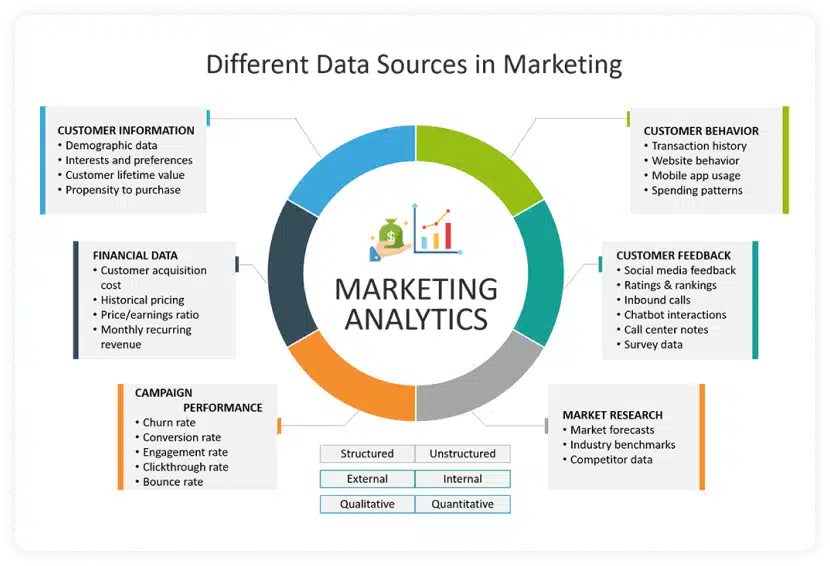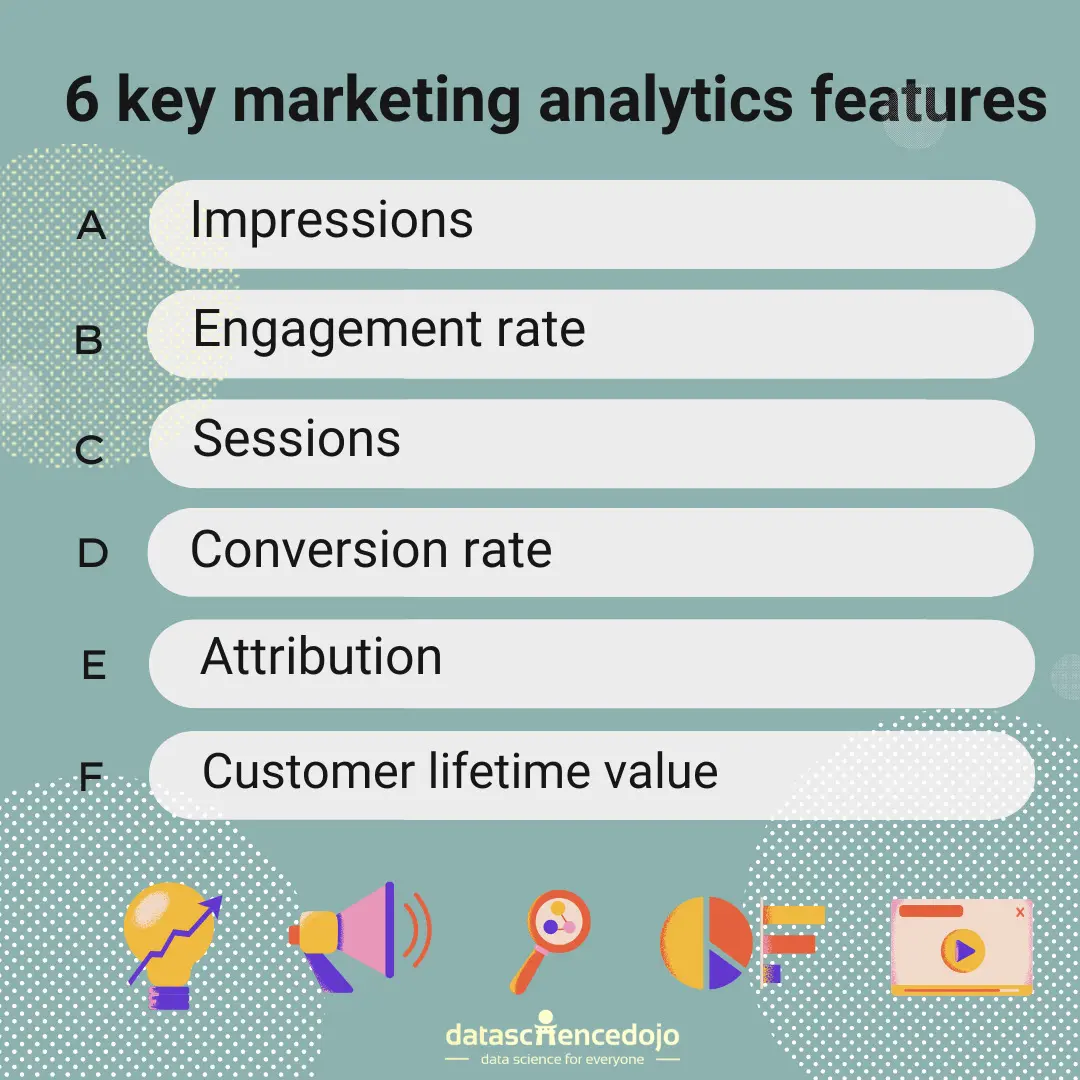The relentless tide of data preserves—customer behavior, market trends, and hidden insights—all waiting to be harnessed. Yet, some marketers remain blissfully ignorant, their strategies anchored in the past.
Explore Top 9 machine learning algorithms to use for SEO & marketing
They ignore the call of data analytics, forsaking efficiency, ROI, and informed decisions. Meanwhile, their rivals ride the data-driven wave, steering toward success. The choice is stark: Adapt or fade into obscurity.
In 2024, the landscape of marketing is rapidly evolving, driven by advancements in data driven marketing and shifts in consumer behavior. Here are some of the latest marketing trends that are shaping the industry:
Impact of AI on Marketing and Latest Trends
1. AI-Powered Intelligence
AI is transforming marketing from automation to providing intelligent, real-time insights. AI-powered tools are being used to analyze customer data, predict behavior, and personalize interactions more effectively.

For example, intelligent chatbots offer real-time support, and predictive analytics anticipate customer needs, making customer experiences more seamless and engaging.
2. Hyper-Personalization
Gone are the days of broad segmentation. Hyper-personalization is taking center stage in 2024, where every customer interaction is tailored to individual preferences.
Advanced AI algorithms dissect behavior patterns, purchase history, and real-time interactions to deliver personalized recommendations and content that resonate deeply with consumers. Personalized marketing campaigns can yield up to 80% higher ROI.
Navigate 5 steps for data driven marketing to improve ROI
Advanced AI algorithms on these platforms analyze customer behavior patterns, purchase history, and real-time interactions to deliver personalized recommendations and offers. This approach can lead to an 80% higher ROI for personalized marketing campaigns.
Understand the roadmap of Llama Index to create personalized Q&A chatbots
3. Enhanced Customer Experience (CX)
Customer experience is a major focus, with brands prioritizing seamless, omnichannel experiences. This includes integrating data across touchpoints, anticipating customer needs, and providing consistent, personalized support across all channels.
Adobe’s study reveals that 71% of consumers expect consistent experiences across all interaction points. Brands are integrating data across touchpoints, anticipating customer needs, and providing personalized support across channels to meet this expectation.
Why Should You Adopt Data Driven Marketing?
Companies should focus on data driven marketing for several key reasons, all of which contribute to more effective and efficient marketing strategies. Here are some compelling reasons, supported by real-world examples and statistics:
-
Enhanced Customer Clarity
Data driven marketing provides a high-definition view of customers and target audiences, enabling marketers to truly understand customer preferences and behaviors.
This level of insight allows for the creation of detailed and accurate customer personas, which in turn inform marketing strategies and business objectives. With these insights, marketers can target the right customers with the right messages at precisely the right time.
Know more about Bringing Smart Customer Management to Life through AI CRM
-
Stronger Customer Relationships at Scale
By leveraging data, businesses can offer a personalized experience to a much wider audience. This is particularly important as companies scale. For example, businesses can use data from various platforms, devices, and social channels to tailor their messages and deliver a superb customer experience at scale.
-
Identifying Opportunities and Improving Business Processes
Data can help identify significant opportunities that might otherwise go unnoticed. Insights such as pain points in the customer experience or hiccups in the buying journey can pave the way for process enhancements or new solutions.
Additionally, understanding customer preferences and behaviors can lead to more opportunities for upselling and cross-selling.
-
Improved ROI and Marketing Efficiency
Data driven marketing allows for more precise targeting, which can lead to higher conversion rates and better ROI. By understanding what drives customer behavior, marketers can optimize their strategies to focus on the most effective tactics and channels.
This reduces wasted spending and increases the efficiency of marketing efforts.
-
Continuous Improvement and Adaptability
A cornerstone of data driven marketing is the continuous gathering and analysis of data. This ongoing process allows companies to refine their strategies in real time, replicating successful efforts and eliminating those that are underperforming. This adaptability is crucial in a rapidly changing market environment.
-
Competitive Advantage
Companies that leverage data driven marketing are more likely to gain a competitive edge. For example, research conducted by McKinsey found that data driven organizations are 23 times more likely to acquire customers, six times more likely to retain them, and 19 times more likely to be profitable.
Real-World Examples
Target: Target used data analytics to identify pregnant customers by analyzing their purchasing patterns. This allowed them to send personalized coupons and marketing messages to expectant mothers, resulting in a significant increase in sales.
Amazon: Amazon uses data analytics to recommend products to customers based on their past purchasing history and browsing behavior, significantly increasing sales and customer satisfaction.
Netflix: Netflix personalizes its content offerings by analyzing customer data to recommend TV shows and movies based on viewing history and preferences, helping retain customers and increase subscription revenues.
Data driven marketing is not just a trend but a necessity in today’s competitive landscape. By leveraging data, companies can make informed decisions, optimize their marketing strategies, and ultimately drive business growth and customer satisfaction.
Top Marketing Analytics Strategies to follow in 2024
Here are some top strategies for marketing analytics that can help businesses refine their marketing efforts, optimize campaigns, and enhance customer experiences:
1. Use Existing Data to Set Goals
Description: Start by leveraging your current data to set clear and achievable marketing goals. This helps clarify what you want to achieve and makes it easier to come up with a plan to get there.
Implementation: Analyze your business’s existing data, figure out what’s lacking, and determine the best strategies for filling those gaps. Collaborate with different departments to build a roadmap for achieving these goals.
2. Put the Right Tools in Place
Description: Using the right tools is crucial for gathering accurate data points and translating them into actionable insights.
Implementation: Invest in a robust CRM focusing on marketing automation and data collection. This helps fill in blind spots and enables marketers to make accurate predictions about future campaigns [5].
3. Personalize Your Campaigns
Description: Personalization is key to engaging customers effectively. Tailor your campaigns based on customer preferences, behaviors, and communication styles.
Implementation: Use data to determine the type of messages, channels, content, and timing that will resonate best with your audience. This includes segmenting and personalizing every step of the sales funnel.
Learn about effective email marketing campaign metrics to measure success
4. Leverage Marketing Automation
Description: Automation tools can significantly streamline data driven marketing processes, making them more manageable and efficient.
Implementation: Utilize marketing automation to handle workflows, send appropriate messages triggered by customer behavior, and align sales and marketing teams. This increases efficiency and reduces staffing costs.
5. Keep Gathering and Analyzing Data
Description: Continuously growing your data collection is essential for gaining more insights and making better marketing decisions.
Implementation: Expand your data collection through additional channels and improve the clarity of existing data. Constantly strive for more knowledge and refine your strategies based on the new data.
6. Constantly Measure and Improve
Description: Monitoring, measuring, and improving marketing efforts is a cornerstone of data driven marketing.
Implementation: Use analytics to track campaign performance, measure ROI, and refine strategies in real time. This helps eliminate guesswork and ensures your marketing efforts are backed by solid data.
7. Integrate Data Sources for a Comprehensive View
Description: Combining data from multiple sources provides a more complete picture of customer behavior and preferences.
Implementation: Use website analytics, social media data, and customer data to gain comprehensive insights. This holistic view helps in making more informed marketing decisions.
8. Focus on Data Quality
Description: High-quality data is crucial for accurate analytics and insights.
Implementation: Clean and validate data before analyzing it. Ensure that the data used is accurate and relevant to avoid misleading conclusions.
9. Use Visualizations to Communicate Insights
Description: Visual representations of data make it easier for stakeholders to understand and act on insights.
Implementation: Use charts, graphs, and dashboards to visualize data. This helps in quickly conveying key insights and making informed decisions.
Read more about 10 data visualization tips to improve your content strategy
10. Employ Predictive and Prescriptive Analytics
Description: Go beyond descriptive analytics to predict future trends and prescribe actions.
Implementation: Use predictive models to foresee customer behavior and prescriptive models to recommend the best actions based on data insights. This proactive approach helps in optimizing marketing efforts.
By implementing these strategies, businesses can harness the full potential of marketing analytics to drive growth, improve customer experiences, and achieve better ROI.
Stay on Top of Data-Driven Marketing
With increasing concerns about data privacy, marketers must prioritize transparency and ethical data practices. Effective data collection combined with robust opt-in mechanisms helps in building and maintaining customer trust.
According to a PwC report, 73% of consumers are willing to share data with brands they trust.
Brands are using data insights to venture beyond their core offerings. By analyzing customer interests and purchase patterns, companies can identify opportunities for category stretching, allowing them to expand into adjacent markets and cater to evolving customer needs.
For instance, a fitness equipment company might launch a line of healthy protein bars based on customer dietary preferences.
Here’s a list of 5 trending AI customer service tools to boost your business
AI is also significantly impacting customer service by improving efficiency, personalization, and overall service quality. AI-powered chatbots and virtual assistants handle routine inquiries, providing instant support and freeing human agents to tackle more complex issues.
AI can also analyze customer interactions to improve service quality and reduce response times. Marketing automation tools are becoming more sophisticated, helping marketers manage data driven campaigns more efficiently.
These tools handle tasks like lead management, personalized messaging, and campaign tracking, enabling teams to focus on more strategic initiatives. Automation can significantly improve marketing efficiency and effectiveness.
These trends highlight the increasing role of technology and data in shaping the future of marketing. By leveraging AI, focusing on hyper-personalization, enhancing customer experiences, and balancing data collection with privacy concerns, marketers can stay ahead in the evolving landscape of 2024.











